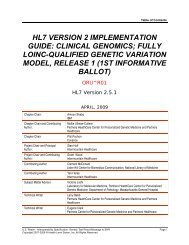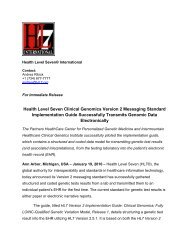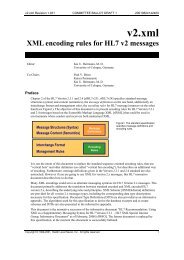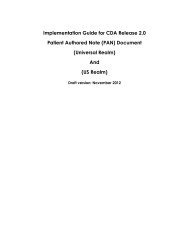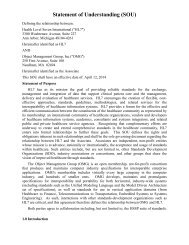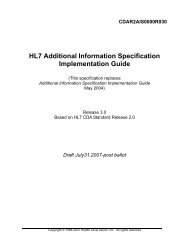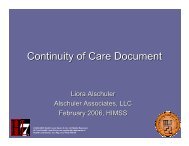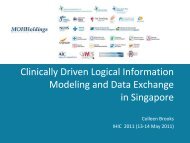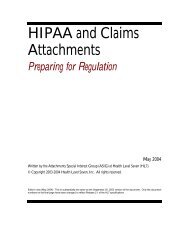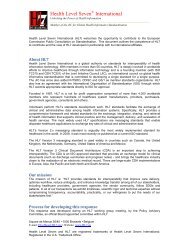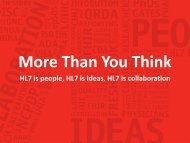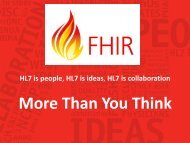Sydney, Australia–Here We Come! - HL7
Sydney, Australia–Here We Come! - HL7
Sydney, Australia–Here We Come! - HL7
Create successful ePaper yourself
Turn your PDF publications into a flip-book with our unique Google optimized e-Paper software.
Liora AlschulerHIMSS Analytics Study to Look at Use of<strong>HL7</strong> Templated CDABy Liora Alschuler, Co-Chair, <strong>HL7</strong> Structured Documents Work Group; Principal, AlschulerAssociates, LLC; Executive Committee Member, Health Story ProjectHIMSS Analytics recently added new questions on useof templated CDA documents to its annual study to helptrack how hospitals are progressing in meeting earlymeaningful use requirements specified in the AmericanRecovery and Reinvestment Act of 2009. The newsection of the survey includes questions about use of<strong>HL7</strong> document specifications that support conversion ofnarrative data to a templated CDA format for import in tothe electronic medical record (EMR). Data gathered fromthe new questions will determine if hospitals have thisinfrastructure in place and how structured documents areused in conjunction with the EMR.HIMSS Analytics tracks the EMR implementation statusof more than 5,000 US, non-governmental hospitalsthrough its annual study with hospital CIOs. The datagathered provides a detailed look at the clinical andfinancial application environments in US hospitals.HIMSS Analytics also developed the Electronic MedicalRecord Adoption Model SM – or EMRAM – to score hospitalsin the HIMSS Analytics Database on their progressin completing the eight stages to creating a paperlesspatient record environment. The <strong>HL7</strong> structured CDAdocuments are now recognized as an important stage inthis progression.Much of the informationin a patient’s medicalrecord may be entered bythe physician or nurse innarrative form, such asnotes taken during a clinicvisit, operative reportsor other information thatcontributes to the completenessof individualhealth history. The Health Story Project is a non-profitcollaborative of healthcare vendors, providers and associationsthat pooled resources over the previous threeyears to accelerate development of data standards toenrich the flow of information between common typesof healthcare documents and EMR systems.Health Story has an Associate Charter Agreement with<strong>HL7</strong> and supported the development of the followingseven <strong>HL7</strong> technical implementation guides: ConsultNote, History and Physical, Operative Note, DiagnosticImaging Report, Discharge Summary, Procedure Note,and Unstructured Document. Work began recently on animplementation guide for Progress Notes. The standardsare based on the <strong>HL7</strong> Clinical Document Architecture reusingtemplates from the Continuity of Care Document.“ARRA funding incentivesare driving EMRimplementation,” saidJohn P. Hoyt, FACHE,FHIMSS, Vice President,HIMSS HealthcareOrganizational Services.“With this expandedarsenal of data, HIMSSAnalytics can helphealthcare providers better understand and follow themeaningful use requirements while moving higher on theEMRAM scale.” HIMSS Analytics expects to begin reportingon hospital readiness for meaningful use in September2010. Learn more at www.himssanalytics.org.Study now includes questions on hospitalreadiness for Meaningful Use,including use of structured templatessupported by the Health Story Projectand developed through <strong>HL7</strong>The members of Health Story anticipate that inclusionof the new questions in the study will help raise awarenessof the availability of the <strong>HL7</strong> structured templatesas resources to support meaningful use and will aid intracking their adoption.For more information on the Health Story Project, pleasevisit www.healthstory.com.SEPTEMBER 201015




